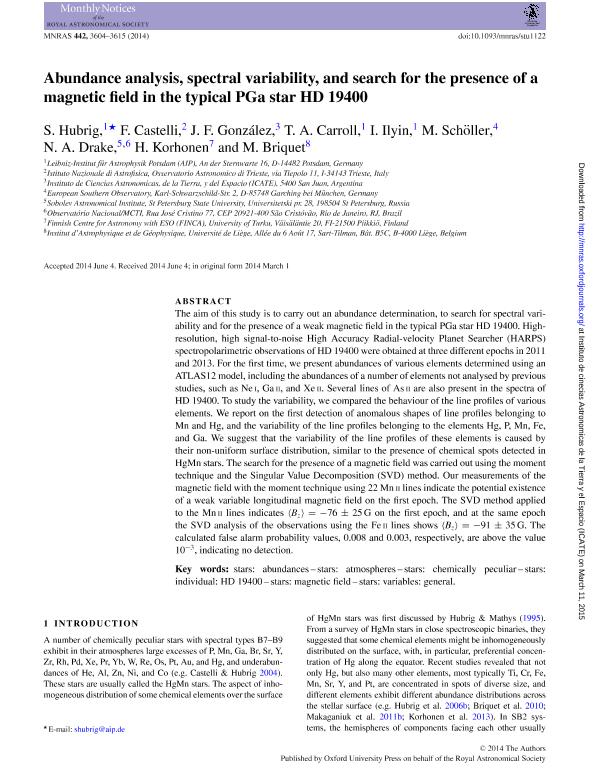Mostrar el registro sencillo del ítem
dc.contributor.author
Hubrig, S.
dc.contributor.author
Castelli, F.
dc.contributor.author
Gonzalez, Jorge Federico

dc.contributor.author
Carroll, T. A.
dc.contributor.author
Ilyin, I.
dc.contributor.author
Schöller, M.
dc.contributor.author
Drake, N. A.
dc.contributor.author
Korhonen, H.
dc.contributor.author
Briquet, M.
dc.date.available
2016-04-01T21:57:55Z
dc.date.issued
2014-08
dc.identifier.citation
Hubrig, S.; Castelli, F.; Gonzalez, Jorge Federico; Carroll, T. A. ; Ilyin, I.; et al.; Abundance analysis, spectral variability, and search for the presence of a magnetic field in the typical PGa star HD 19400; Oxford University Press; Monthly Notices of the Royal Astronomical Society; 442; 4; 8-2014; 3604-3615
dc.identifier.issn
0035-8711
dc.identifier.uri
http://hdl.handle.net/11336/4997
dc.description.abstract
The aim of this study is to carry out an abundance determination, to search for spectral variability and for the presence of a weak magnetic field in the typical PGa star HD 19400. High-resolution, high signal-to-noise High Accuracy Radial-velocity Planet Searcher (HARPS) spectropolarimetric observations of HD 19400 were obtained at three different epochs in 2011 and 2013. For the first time, we present abundances of various elements determined using an ATLAS12 model, including the abundances of a number of elements not analysed by previous studies, such as Ne I, Ga II, and Xe II. Several lines of As II are also present in the spectra of HD 19400. To study the variability, we compared the behaviour of the line profiles of various elements. We report on the first detection of anomalous shapes of line profiles belonging to Mn and Hg, and the variability of the line profiles belonging to the elements Hg, P, Mn, Fe, and Ga. We suggest that the variability of the line profiles of these elements is caused by their non-uniform surface distribution, similar to the presence of chemical spots detected in HgMn stars. The search for the presence of a magnetic field was carried out using the moment technique and the Singular Value Decomposition (SVD) method. Our measurements of the magnetic field with the moment technique using 22 Mn II lines indicate the potential existence of a weak variable longitudinal magnetic field on the first epoch. The SVD method applied to the Mn II lines indicates 〈Bz〉 = −76 ± 25 G on the first epoch, and at the same epoch the SVD analysis of the observations using the Fe II lines shows 〈Bz〉 = −91 ± 35 G. The calculated false alarm probability values, 0.008 and 0.003, respectively, are above the value 10−3, indicating no detection.
dc.format
application/pdf
dc.language.iso
eng
dc.publisher
Oxford University Press

dc.rights
info:eu-repo/semantics/openAccess
dc.rights.uri
https://creativecommons.org/licenses/by-nc-sa/2.5/ar/
dc.subject
Stars: Abundances
dc.subject
Stars: Atmospheres
dc.subject
Stars: Chemically Peculiar
dc.subject
Stars: Magnetic Field
dc.subject
Stars: Variables: General
dc.subject.classification
Astronomía

dc.subject.classification
Ciencias Físicas

dc.subject.classification
CIENCIAS NATURALES Y EXACTAS

dc.title
Abundance analysis, spectral variability, and search for the presence of a magnetic field in the typical PGa star HD 19400
dc.type
info:eu-repo/semantics/article
dc.type
info:ar-repo/semantics/artículo
dc.type
info:eu-repo/semantics/publishedVersion
dc.date.updated
2016-05-06 15:52:43.262787-03
dc.journal.volume
442
dc.journal.number
4
dc.journal.pagination
3604-3615
dc.journal.pais
Reino Unido

dc.journal.ciudad
Oxford
dc.conicet.avisoEditorial
This article has been accepted for publication in Monthly Notices of the Royal Astronomical Society ©: 2014 [owner as specified on the article] Published by Oxford University Press on behalf of the Royal Astronomical Society. All rights reserved.
dc.description.fil
Fil: Hubrig, S.. Leibniz-Institut fur Astrophysik Potsdam; Alemania
dc.description.fil
Fil: Castelli, F.. Istituto Nazionale di Astrofisica. Osservatorio Astronomico di Trieste; Italia
dc.description.fil
Fil: Gonzalez, Jorge Federico. Consejo Nacional de Investigaciones Cientificas y Tecnicas. Centro Cientifico Tecnologico San Juan. Instituto de Ciencias Astronomicas de la Tierra y del Espacio; Argentina
dc.description.fil
Fil: Carroll, T. A. . Leibniz-Institut fur Astrophysik Potsdam; Alemania
dc.description.fil
Fil: Ilyin, I.. Leibniz-Institut fur Astrophysik Potsdam; Alemania
dc.description.fil
Fil: Schöller, M.. European Southern Observatory; Alemania
dc.description.fil
Fil: Drake, N. A.. St Petersburg State University. Sobolev Astronomical Institute; Rusia. Observatorio Nacional/MCTI; Brasil
dc.description.fil
Fil: Korhonen, H.. University of Turku. Finnish Centre for Astronomy with ESO; Finlandia
dc.description.fil
Fil: Briquet, M.. Université de Liège. Institut d’Astrophysique et de Geophysique; Bélgica
dc.journal.title
Monthly Notices of the Royal Astronomical Society

dc.relation.alternativeid
info:eu-repo/semantics/altIdentifier/url/http://mnras.oxfordjournals.org/content/442/4/3604.abstract
dc.relation.alternativeid
info:eu-repo/semantics/altIdentifier/doi/http://dx.doi.org/10.1093/mnras/stu1122
dc.relation.alternativeid
info:eu-repo/semantics/altIdentifier/doi/10.1093/mnras/stu1122
dc.relation.alternativeid
info:eu-repo/semantics/altIdentifier/url/http://arxiv.org/abs/1406.1927v1
dc.relation.alternativeid
info:eu-repo/semantics/altIdentifier/arxiv/1406.1927v1
Archivos asociados
